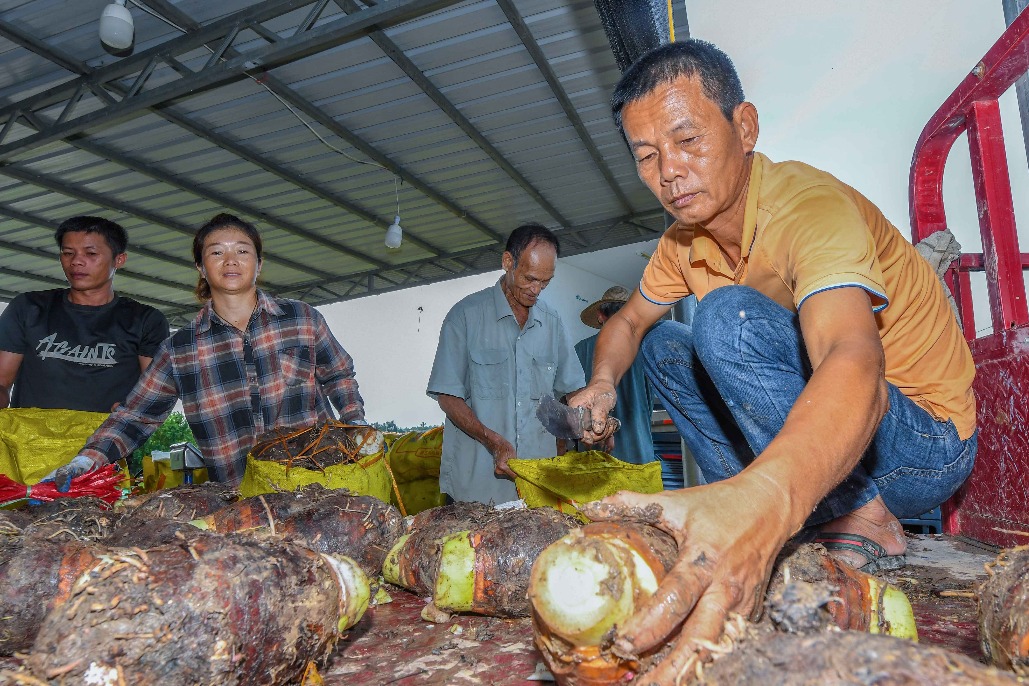Nation's green solutions powering the planet


World benefiting from strong support for renewables
On a huge area of land 10 times bigger than New York's Central Park, the world's biggest solar farm is taking shape.
When completed next year, the $4 billion Benban park in Egypt will generate 1.8 gigawatts of electricity, and directly avoid 2 million metric tons of carbon dioxide emissions that would otherwise have been created by alternative power generation sources.
The 36-square-kilometer solar project is a flagship success story in the green finance industry, which has grown at a quicker pace in recent years as the threat of climate change becomes more apparent.
But one key factor that has made this park not just an ecological showcase but also a financially profitable project is the global fall in the cost of producing solar energy, thanks to China's financial support that has allowed this renewable sector to achieve efficiencies of scale.
Harry Boyd-Carpenter, head of power and energy utilities at the European Bank for Reconstruction and Development, said: "The scale, the innovation and the brutal competition of China's domestic solar market has driven prices down. This has allowed a country like Egypt to access cheap solar panels."
China has become the new leader in renewable energy investment in recent years, anchoring clean energy industries with confidence, especially after the United States' decision to withdraw from the Paris climate agreement.
Last year, China invested more than $44 billion in clean energy projects, a significant rise on the $32 billion in 2016. These investments have resulted in technological breakthroughs for a variety of renewable resources, including hydro, wind, solar and bioenergy.
The benefits are not restricted to China. The solar sector, for instance, realized a 70 percent reduction in production costs from 2010 to last year, making projects such as the Benban park financially viable.
Boyd-Carpenter said, "Chinese solar panel manufacturers have competed to drive down costs for the domestic market, and the rest of the world is getting benefits from this."
The country's commitment to sustainable investments has also made it a leader in green finance.
For example, in 2016, when China launched its green bond market, such bonds issued in the country reached a whopping 205.2 billion yuan ($32.4 billion), making it the world's largest issuer of the bonds, and accounting for 40 percent of those issued globally.
This year, China became the first country to make it compulsory for all listed companies and bond issuers to disclose environmental, social and governance risks associated with their operations by 2020.
Unprecedented growth
The country has also led green finance regulatory advancement overseas. In 2016, it used its presidency of the G20 Global Leaders Summit to put green finance on the agenda for the first time, and has since worked closely with central banks around the world to advance green finance policies.
Mathias Lund Larsen, director of international cooperation at the Institute of Green Finance, a Beijing think tank, said: "It is the first time a country has taken such a comprehensive approach to greening the financial system. Given China's success in pace and scale, other countries are starting to experiment with similar approaches."
Green finance has become a hot topic in the financial industry in recent years, partly due to its unprecedented growth.
When the World Bank's environment department issued the first green bond in 2008, few investors understood the new asset class. Consequently, the funds raised were small-in the tens of millions of dollars-and there were few investors.
Since then, the market has taken off. In 2014 alone, the issuance of green bonds tripled.
What makes green bonds special is that the funds raised have to go into environmentally friendly projects, such as renewable energy, energy-efficient buildings, or electric vehicles.
The fact that these projects will continue to generate good financial returns despite increasingly strict environmental laws means green bonds are popular among long-term investors, such as pension funds.
Encouraged by the success of these bonds, other green products have emerged, including loans and equities. Regulators have also drawn up rules that support the sector's growth, and banks have worked together to develop better ways to identify green projects they can finance.
China is an active player on platforms where such topics are being discussed and addressed, including the World Bank Sustainable Banking Network, the G20 and the Central Banks and Supervisors Network for Greening the Financial System.
Alzbeta Klein, director and global head of International Finance Corp's Climate Business, said, "China's role is absolutely critical in climate change mitigation and therefore climate finance." The country's seat on international green finance platforms is key to ensuring the regulations made for this sector are suitable for emerging economies' energy transition, Klein said.
"This is important, particularly because new energy solutions can help many emerging economies skip some of the steps developed markets have experienced in energy transition, to leapfrog to greener growth," Klein said.
Since the US backed away from the Paris agreement, governments and businesses have looked to China for leadership to advance the green finance sector. For instance, the Californian government took a bold step to work directly with China on climate finance.
In September, China and California launched the China-California Cleantech Partnership Fund, which is designed to facilitate investment in clean technological innovation.
Equipped with experience in financing green projects at home, Chinese banks are increasingly financing such projects overseas. For example, the Industrial and Commercial Bank of China teamed up with the European Bank for Reconstruction and Development to finance part of the Benban solar park in Egypt.
Boyd-Carpenter, from the EBRD, said: "Chinese banks are good at taking a long-term view of financing. They are not afraid of long-term infrastructure risk. That makes them good partners for us."
Other Chinese banks active in financing overseas green projects include the China Development Bank, the Export-Import Bank of China, and the Industrial and Commercial Bank of China. Green finance is also at the heart of the China-led Asian Infrastructure Investment Bank, as illustrated in its slogan "lean, clean and green".
Challenges remain
Despite the opportunities, the global green finance industry still needs to overcome some critical challenges to take its impact to the next level, and the world is looking to China to take a leading role on this.
One particular challenge is the different green bond standards used in China and internationally. Although the differences are small, a significant one is that the Chinese standards allow proceeds from green bonds to be invested in clean coal, while international standards do not.
Larsen, from the Institute of Green Finance, said, "This leads to unnecessary complications for green bond issuers, and reduced confidence among investors."
As a result, international investors wanting to buy China-issued green bonds often cannot, because they feel the Chinese bonds' potential financing for clean coal is incompatible with their vision of sustainable investment.
To address this challenge, Chinese regulators are working with the European Union to "harmonize" both standards.
"Such efforts toward green standard harmonization provide the necessary clarity for all financial stakeholders to increase their green finance efforts based on clear definitions," Larsen said.
- Nation's health outcomes gain recognition
- Sichuan's ethnic festival attracts thousands of tourists
- SCO Digital Economy University Alliance launched
- Experience from a first-person perspective a sniper shooting from a boat
- Humble root crop becomes vital industry in Haikou village
- Sniper showdown on water: Realistic battlefield simulation





































